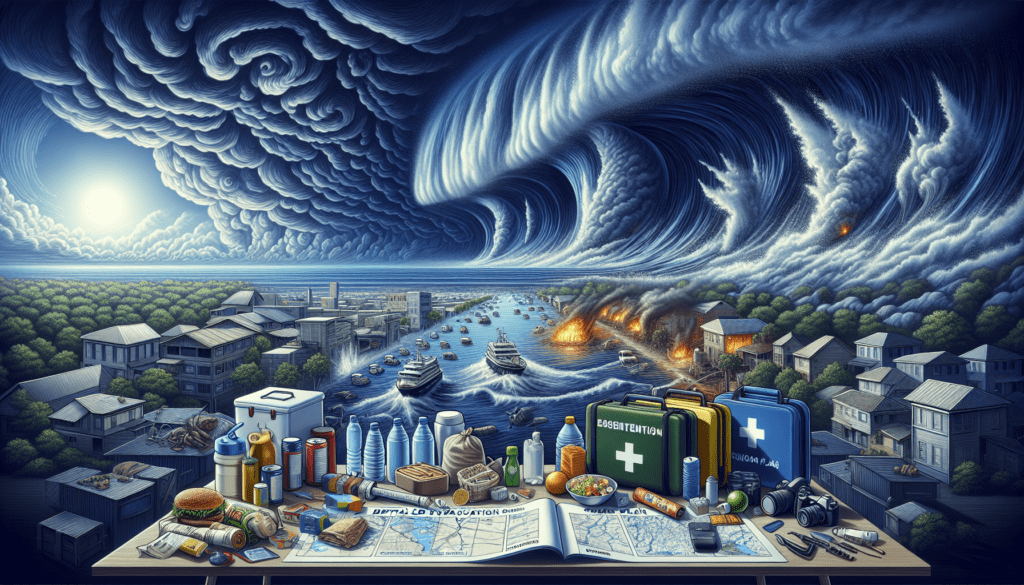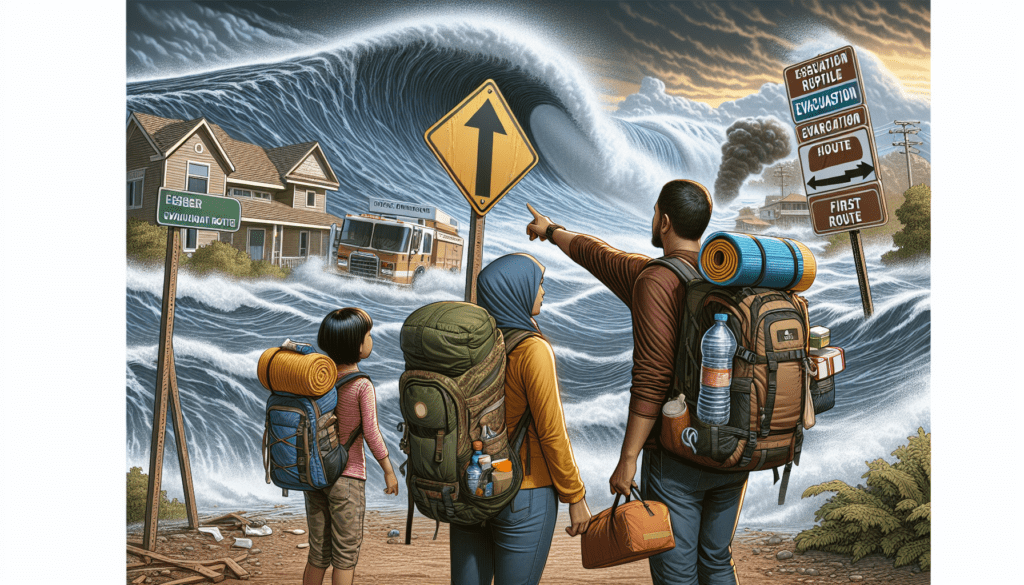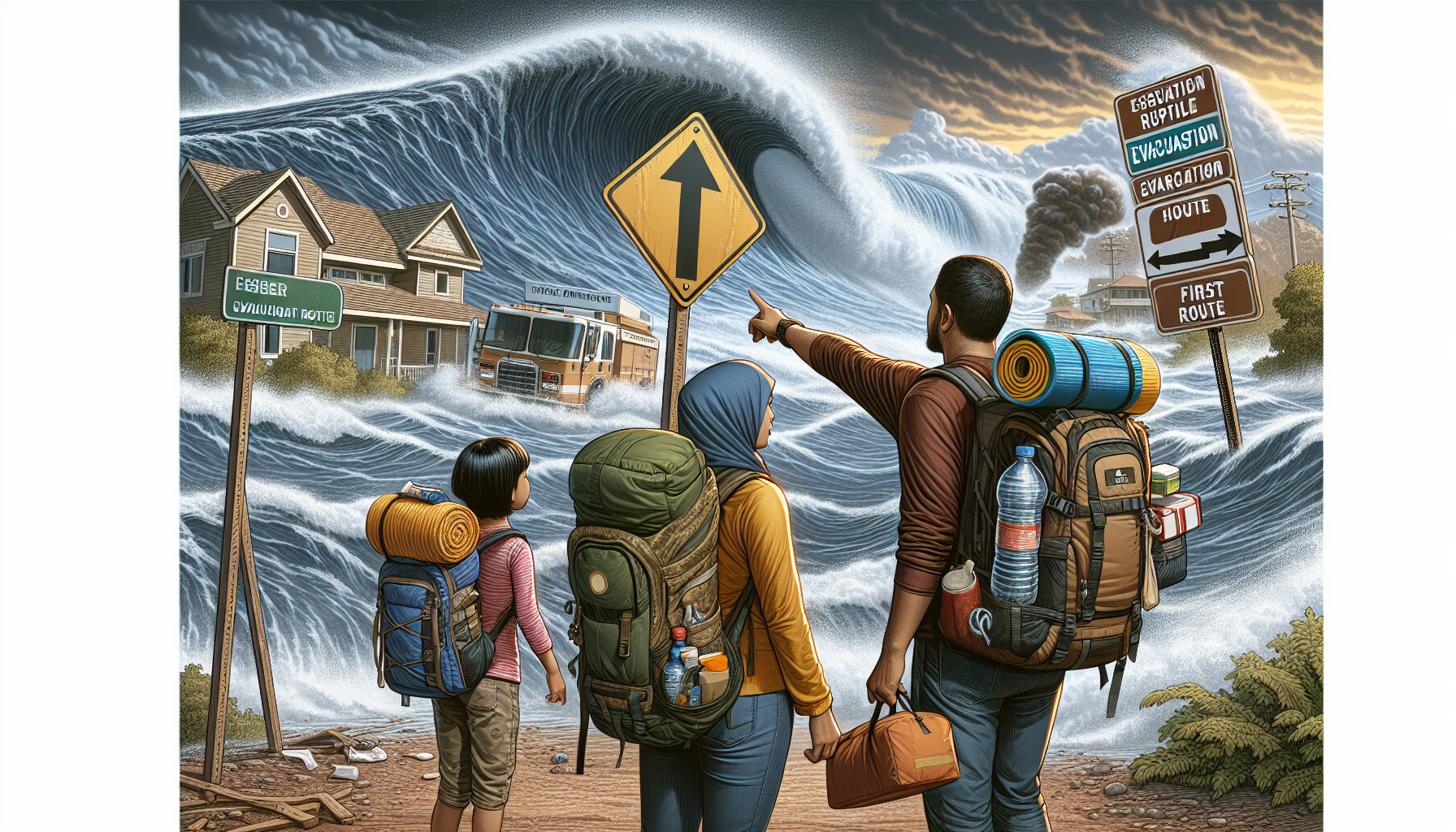In “Surviving Tsunamis And Floods: A Guide,” you will find essential information and practical tips to help you navigate the dangerous waters of natural disasters. From understanding the warning signs to preparing an emergency kit, this comprehensive guide will equip you with the knowledge and tools needed to increase your chances of survival. Whether you live in a high-risk area or simply want to be prepared for any situation, this article will provide you with invaluable insights and strategies to stay safe in the face of tsunamis and floods.
Understanding Tsunamis and Floods
Tsunamis and floods are natural disasters that can cause significant destruction and loss of life. While they share some similarities, it is important to understand the differences between the two.
What are tsunamis?
Tsunamis are large waves typically triggered by undersea earthquakes, volcanic eruptions, or landslides. Unlike normal ocean waves, tsunamis have much longer wavelengths and travel at high speeds. When they reach shallow water near the coast, the energy of the tsunami is compressed, causing the wave to rise dramatically and flood the land.
What are floods?
Floods, on the other hand, occur when water overwhelms normally dry land areas. This can happen due to heavy rainfall, dam or levee failures, or the rapid melting of snow and ice. Floods can occur slowly over an extended period or happen suddenly with flash floods, causing widespread damage to infrastructure, homes, and agricultural land.
Causes of tsunamis
Tsunamis are primarily caused by seismic events, such as earthquakes, where the movement of tectonic plates generates massive amounts of energy that displace the ocean water. This displacement creates large waves that can travel across entire ocean basins before striking coastal areas.
Causes of floods
Floods can be caused by various factors, including intense rainfall, tropical storms and hurricanes, dam failures, or the overflow of rivers, lakes, and reservoirs. Climate change and urban development in flood-prone areas have also contributed to the increased frequency and severity of floods in recent years.
Differences between tsunamis and floods
While both tsunamis and floods involve the movement of water onto normally dry land, there are several significant differences between the two. Tsunamis are typically triggered by seismic events, whereas floods can be caused by various factors. Tsunamis are characterized by extremely long wavelengths and high speeds, making them highly destructive when they reach the coast. Floods, on the other hand, can be slow or sudden and can occur in a variety of locations. Both tsunamis and floods can cause significant damage, but understanding their unique characteristics is essential for preparedness and response efforts.
Preparing for Tsunamis and Floods
Preparing for tsunamis and floods can greatly increase your chances of survival and minimize property damage. Here are some essential steps to take:
Developing an emergency plan
Create a detailed plan for you and your family that outlines evacuation routes, safe meeting points, and a communication strategy. Assign responsibilities to each family member and practice the plan regularly to ensure everyone knows what to do in an emergency.
Creating an emergency kit
Assemble an emergency kit that includes basic supplies such as food, water, medication, clothing, flashlights, and a battery-powered radio. Ensure that your kit can sustain you and your family for at least three days.
Educating yourself and your family
Learn about the signs of an impending tsunami or flood and educate your family on how to recognize these signs. Share knowledge about evacuation procedures, emergency contacts, and the location of designated shelters.
Knowing the evacuation routes
Familiarize yourself with the evacuation routes in your area and understand the best options for reaching higher ground or designated safety zones. Ensure that your vehicle is in good working condition and always keep your gas tank at least half full in case of an emergency.
Understanding warning signs
Pay attention to official warnings from local authorities and be aware of natural signs of an impending tsunami or flood, such as rapidly receding water, the ground shaking, or unusual animal behavior. Take immediate action if you observe any signs indicating danger.

Staying Safe During Tsunamis
When a tsunami warning is issued, taking the right precautions can save your life. Here are some key steps to stay safe during a tsunami:
Monitoring official alerts
Stay tuned to radio, television, or emergency notification systems for updates and instructions from authorities. Follow their guidance promptly and do not delay in taking action.
Evacuating to higher ground
When a tsunami warning is issued, evacuate immediately to higher ground or an inland location as advised by local authorities. Move quickly and help others who may need assistance, but do not wait if you feel threatened.
Avoiding rivers and coastal areas
During a tsunami, avoid rivers, coastal areas, and beaches. Tsunamis can produce strong and unpredictable currents that can easily overwhelm and endanger individuals in these locations.
Seeking shelter in a sturdy building
If evacuation is not possible, seek shelter on higher floors or in a sturdy building with reinforced walls and a strong foundation. Stay away from windows and exterior walls and have your emergency kit and communication devices with you.
Staying tuned to the emergency radio
Continue to listen to the emergency radio for updates and instructions from authorities until the all-clear signal has been given. Do not assume it is safe to return to your home or the coast until you have received official confirmation.
Staying Safe During Floods
Flooding can be a dangerous and unpredictable situation. Follow these guidelines to ensure your safety during a flood:
Heeding evacuation orders
If you receive an evacuation order from local authorities, leave immediately. Do not hesitate or underestimate the severity of the situation. It is better to be safe and evacuate early than to be trapped in a dangerous situation later.
Avoiding floodwaters
Never attempt to walk, swim, or drive through floodwaters. The current can be strong and unpredictable, and even shallow water can sweep you off your feet. Floodwaters can also be contaminated with sewage and other hazardous substances.
Moving to higher ground
If you cannot evacuate, move to higher ground within your building or to the highest level of your property. Seek shelter in an area that is least likely to be affected by the rising water, such as an attic or the roof.
Ensuring safe drinking water
During a flood, your drinking water supply may become contaminated. Use bottled water or boil tap water before consuming it. If neither is available, use water purification tablets or a portable water filter.
Using caution during rescue or relief efforts
If you are involved in rescue or relief efforts, follow the instructions of emergency personnel and exercise caution. Rescues should be left to trained professionals, and it is important to prioritize your own safety while helping others.

Building Resilient Structures
Constructing buildings and infrastructure that can withstand tsunamis and floods is crucial for reducing damage. Consider the following measures:
Designing for floods and tsunamis
When building in flood or tsunami-prone areas, work with architects and engineers who specialize in designing structures to withstand these natural disasters. Use materials and construction techniques that are resistant to water damage.
Elevating structures
Elevate buildings above the expected flood or tsunami levels to minimize the risk of structural damage. Incorporate elevated platforms, stilts, or adjustable foundations to raise the main occupied levels of the building.
Installing flood barriers and breakwaters
Deploy flood barriers, protective walls, or breakwaters to divert or reduce the force of floodwater or tsunamis. These barriers can help protect buildings, infrastructure, and coastal areas from the destructive impact of water.
Creating resilient infrastructure
Invest in durable and resilient infrastructure such as bridges, roads, and drainage systems that can withstand flood events. Design these structures to accommodate large volumes of water and prevent damage or disruption.
Implementing early warning systems
Install and maintain early warning systems that can detect potential tsunamis or floods and provide timely alerts to communities at risk. These systems can significantly reduce response times and save lives.
Creating Community Preparedness
Building community resilience is essential for effectively responding to tsunamis and floods. Strengthen your community’s preparedness with the following steps:
Organizing community drills and exercises
Coordinate community drills and exercises to practice evacuation procedures, response plans, and communication protocols. These activities can help identify areas for improvement and build confidence in emergency preparedness.
Establishing emergency communication networks
Create a reliable emergency communication network within your community. This can include systems such as community text alert networks, community radio stations, or designated community leaders who can disseminate information during emergencies.
Providing first aid and medical support
Train community members in basic first aid and CPR techniques. Establish medical support teams or volunteer groups that can provide immediate assistance during disasters, mitigating the impact on affected individuals.
Training local volunteers
Recruit and train volunteers from within the community who can assist in various aspects of disaster response, including search and rescue, distribution of emergency supplies, and providing support to affected individuals.
Developing a community response plan
Collaborate with local authorities, nonprofits, and community leaders to develop a comprehensive response plan that outlines roles, responsibilities, and actions to be taken in the event of a tsunami or flood. Regularly review and revise the plan to incorporate lessons learned from past emergencies.
Emergency Supplies and Equipment
Having the right supplies and equipment can make a significant difference in your safety and comfort during a tsunami or flood. Ensure you have the following essentials:
Essential items for survival kits
Include essential items in your survival kit, such as non-perishable food, bottled water, a first aid kit, blankets, a flashlight, extra batteries, a whistle, a multipurpose tool, and personal hygiene products. Customize your kit based on the needs of your family.
Emergency food and water storage
Store an adequate supply of non-perishable food and clean drinking water in a safe and accessible location. Aim to have at least three days’ worth of supplies for each family member.
Lighting and communication devices
Have a battery-powered or hand-cranked flashlight, as well as spare batteries, in your emergency kit. Additionally, include a battery-powered or hand-cranked radio to stay informed about official updates and instructions.
First aid supplies
Keep a well-stocked first aid kit that includes bandages, antiseptics, pain relievers, prescription medications, and any necessary medical supplies. Ensure your kit is regularly checked and replenished.
Rescue tools and equipment
Include a whistle or air horn in your kit to alert rescuers to your location. Additionally, consider having a multi-tool, rope, and life jackets in case you need to navigate floodwaters or assist others during a rescue.
Coping with Emotional Impact
Experiencing a natural disaster such as a tsunami or flood can have a significant emotional impact. It is important to address and cope with these effects effectively:
Understanding the psychological effects
Recognize that a natural disaster can lead to a wide range of emotional responses, including fear, anxiety, grief, and a sense of loss. Understand that these reactions are normal and that it may take time to recover emotionally.
Seeking emotional support
Reach out to friends, family, or professionals for emotional support. Discussing your experiences and feelings with others who have shared similar experiences can be comforting and validating.
Counseling and therapy resources
If you find that your emotional distress persists or becomes overwhelming, consider seeking professional counseling or therapy. Mental health professionals can offer guidance and support to help you recover and rebuild your emotional well-being.
Supporting children and vulnerable individuals
Pay close attention to the needs of children, elderly individuals, and those with disabilities or special needs. Provide them with reassurance, comfort, and the necessary support to cope with the emotional impact of the disaster.
Building resilience in the aftermath
Focus on building resilience by engaging in activities that promote emotional healing and recovery. This can include exercising, practicing relaxation techniques, connecting with nature, or engaging in creative outlets such as writing or art.
Emergency Aftercare and Recovery
After a tsunami or flood, it is crucial to assess damages, ensure safety, and begin the process of recovery. Follow these steps:
Assessing damages and safety hazards
After the immediate danger has passed, carefully assess the damages to your property and surrounding areas. Look for any structural damage, hazardous materials, or utility disruptions that may pose a risk to your safety.
Cleaning and disinfecting
Thoroughly clean and disinfect your home and belongings to mitigate the risk of contamination from floodwaters. Use appropriate cleaning agents, wear protective clothing, and follow guidelines from local health authorities.
Restoring utilities and infrastructure
Work with relevant utility companies and authorities to restore essential services such as electricity, water, and gas. Only attempt to restore services if it is safe to do so, and follow any instructions or recommendations provided by professionals.
Accessing financial assistance
Check with local disaster relief organizations, government agencies, and insurance providers to inquire about available financial assistance and support programs. Document all damages with photographs and records to facilitate the claims process.
Ensuring long-term community resilience
Collaborate with your community and local authorities to develop long-term plans for future resilience and disaster preparedness. Share your experiences and observations to contribute to improvements in emergency response and recovery efforts.
Learning from Past Disasters
Studying and analyzing past tsunamis and floods can help improve disaster management strategies and promote policy changes. Consider the following steps:
Studying historical tsunamis and floods
Research and learn about past tsunamis and floods that have occurred in your region. Gain knowledge about the causes, impacts, and response efforts to better understand the risks and vulnerabilities of your community.
Analyzing successful disaster management strategies
Identify and analyze successful disaster management strategies implemented in other regions or countries. Learn from their experiences and adapt effective approaches to strengthen your own preparedness and response plans.
Improving early warning systems
Advocate for the improvement and expansion of early warning systems in your region. Support initiatives that enhance the accuracy, timeliness, and accessibility of tsunami and flood warnings to ensure the safety of your community.
Sharing lessons learned
Participate in local and international forums, conferences, and workshops to share your experiences and lessons learned from past disasters. By exchanging knowledge, best practices, and challenges, communities can collectively enhance their resilience.
Driving policy changes
Engage with policymakers, government agencies, and local representatives to advocate for policy changes that prioritize disaster preparedness, risk reduction, and resilience. Emphasize the importance of sustainable infrastructure development and community empowerment in minimizing the impacts of future tsunamis and floods.
Surviving tsunamis and floods requires knowledge, preparedness, and community resilience. By understanding the nature of these disasters, preparing for emergencies, and learning from past experiences, individuals and communities can enhance their chances of survival and recovery in the face of these powerful forces of nature.

